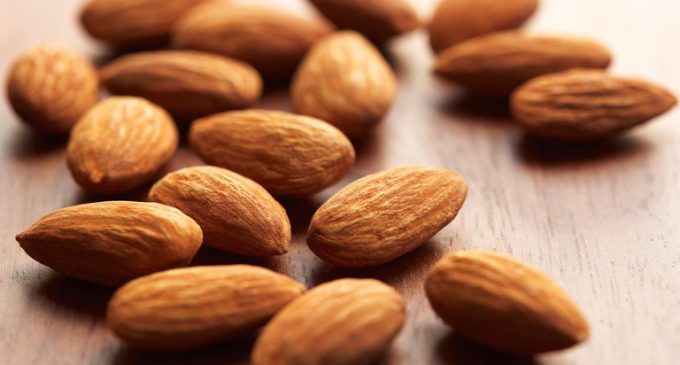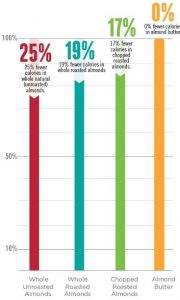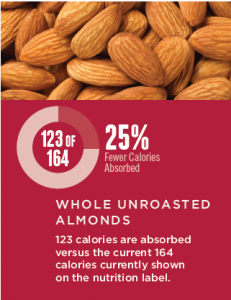Almonds – When is a Calorie Not a Calorie?

New data from the US Department of Agriculture (USDA) shows that both roasted and unroasted almonds provide fewer calories than thought – and that the number of calories is largely dependent on form1 . The study, conducted by scientists from USDA’s Agricultural Research Service (ARS) and jointly funded by USDA ARS and Almond Board of California, shows that compared to the number of calories listed on nutrition labels, participants actually absorbed 25% fewer calories from whole unroasted almonds and 19% fewer calories from whole roasted almonds.
David Baer, PhD, and his team from USDA’s Agricultural Research Service (ARS) conducted a controlled human clinical trial using a new method to measure the calories absorbed from almonds, taking bioavailability into account. The new method allowed the researchers to determine the number of calories actually digested and absorbed from almonds.
Traditionally, calories are determined using what are known as the Atwater factors, which was developed over 100 years ago, and assigns an estimated number of calories per gram of fat, protein and carbohydrate in a food. “We expanded upon the Atwater method in our study, so we could tease out the caloric value of a single target food,” explains Janet Novotny, PhD, a physiologist and mathematician with the research team. “Then using the study participants’ energy intake and energy output, we were able to measure the number of calories actually digested and absorbed from a single food – in this case, almonds.”
 In 2012, the researchers conducted their first study using whole roasted almonds, which showed that the almonds provided fewer calories than thought2 . This time, the research team broadened their investigation to examine the calorie availability of additional almond forms, and also replicated the measurement of calories absorbed from whole roasted almonds. The researchers found that whole unroasted almonds provided 25% fewer calories than expected, while whole roasted almonds provided 19% fewer calories. Chopped roasted almonds provided 17% fewer calories, though the difference between the calories absorbed from chopped and whole roasted almonds was not statistically different. Measured calories in almond butter did not differ from calories estimated using Atwater factors.
In 2012, the researchers conducted their first study using whole roasted almonds, which showed that the almonds provided fewer calories than thought2 . This time, the research team broadened their investigation to examine the calorie availability of additional almond forms, and also replicated the measurement of calories absorbed from whole roasted almonds. The researchers found that whole unroasted almonds provided 25% fewer calories than expected, while whole roasted almonds provided 19% fewer calories. Chopped roasted almonds provided 17% fewer calories, though the difference between the calories absorbed from chopped and whole roasted almonds was not statistically different. Measured calories in almond butter did not differ from calories estimated using Atwater factors.
Why the discrepancy between the two methods of determining calories? The Atwater method of calculating calories may overstate the calories from almonds because it simply doesn’t account for the fact that not all calories from almonds are available to the body. The chewing process does not completely break down almond cell walls, and almonds are therefore not completely absorbed during digestion.
 And why the calorie difference between almond forms? Much of this finding has to do with particle size after chewing and digestion. The larger the particle size, after chewing for example, the less the almond is able to be broken down by digestive enzymes and more of the almond is excreted, so fewer calories are absorbed. The reverse is also true: the smaller the particle size, the more almond cells are exposed to digestive enzymes and the more calories are absorbed. In addition to chewing and digestion, mechanical processes, such as chopping, grinding and roasting almonds can also impact particle size.
And why the calorie difference between almond forms? Much of this finding has to do with particle size after chewing and digestion. The larger the particle size, after chewing for example, the less the almond is able to be broken down by digestive enzymes and more of the almond is excreted, so fewer calories are absorbed. The reverse is also true: the smaller the particle size, the more almond cells are exposed to digestive enzymes and the more calories are absorbed. In addition to chewing and digestion, mechanical processes, such as chopping, grinding and roasting almonds can also impact particle size.
According to David Baer, PhD: “Calories are created equal but their availability from foods is not equal. These new findings confirm that we actually get fewer calories than we thought from almonds, whether they are whole or chopped, roasted or unroasted, and the amount of calories absorbed is mostly dependent on the form of almonds consumed.” Further research is needed to better understand the results of this study and how this method of measuring calories could potentially affect the calorie count of other foods.
1 Gebauer SK, Novotny JA, Bornhorst GM and Baer DJ. Food processing and structure impact the metabolizable energy of almonds. Food & Function. 2016;7(10):4231-4238.
2 Novotny JA, Gebauer SK, Baer DJ. Discrepancy between the Atwater factor predicted and empirically measured energy values of almonds in human diets. American Journal of Clinical Nutrition. 2012;96(2):296-301.


































